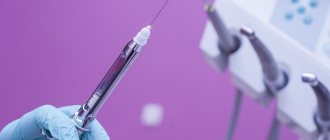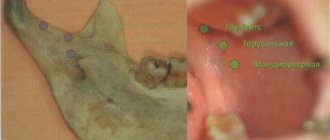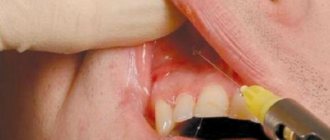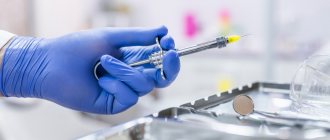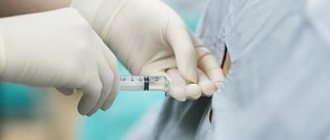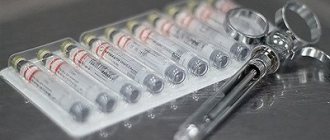Conduction anesthesia of the nasopalatine nerve at the incisive foramen
The nasopalatine nerve, one of the nasal nerves of the nasal septum that innervates the nasal septum, begins at the sphenopalatine ganglion, passes along the nasal septum obliquely and medially forward, and enters the incisive canals on both sides of the nasal septum.
Both bone canals, starting on both sides of the nasal septum in the nasal cavity, passing through the hard palate, merge into one canal, which opens from the side of the oral cavity behind the central incisors with one hole - the incisive one.
Thus, both nasopalatine nerves exit through one opening - the incisive one, innervate the mucous membrane of the anterior part of the palate and anastomose with the branches of the anterior palatine nerves. Therefore, we are able to turn off the innervation of both nasopalatine nerves in the anterior part of the palate with one injection into the incisive foramen.
Location of the incisive foramen (target point). One line on which this opening is located is always accessible to us, this is the line of the median palatine suture, sutura palatina mediana. If we find such a definite and accessible line to us that would intersect the median palatal suture at the site of the incisive foramen, or if we know the distance of the incisive foramen at the indicated suture from some constant and accessible point to us, then our goal will be achieved and the location of the incisive foramen on the mucous membrane the shell of the sky was found. A constant perpendicular crossing the midpalatal suture at the site of the incisive foramen is the line connecting the distal edges of both upper canines. The constant points on the median palatal suture, the distances from which to the incisive foramen determine the location of the latter, are the place of contact of the upper central incisors and the edge of the alveolar process between them.
Our measurements of these distances on 75 adult and 30 children’s turtles gave the following results:
| Objects of research | Distance of the incisal foramen from the point of contact of the upper central incisors (in mm) | Distance of the incisal foramen from the alveolar edge between the upper central incisors (in mm) |
| Children | 9 | 5 |
| Adults | 10 | 8 |
Having several identification points, you can use others if some are missing.
Cyst of the nasopalatine (incisive) canal
The nasopalatine canal cyst (incisive canal cyst) was first described by Meyer in 1914. These incisive canal cysts (nasopalatine duct cysts) are non-tumor cysts that arise from degeneration of the nasopalatine ducts. The ducts are usually obliterated in utero. Persistence of the ductal epithelium leads to the formation of a cyst. The structure of the epithelial lining of the nasopalatine canal is not the same. Closer to the nasal cavity, the epithelium of the canal is cylindrical or ciliated; the section of the canal adjacent to the oral cavity is lined with flat epithelium. In connection with these features of the epithelial lining of the nasopalatine canal, the structure of the cyst shell depends on its location. If the cyst is located closer to the nasal cavity, its shell is lined with columnar or ciliated epithelium, and the cysts of the lower parts of the canal contain a lining of stratified squamous epithelium. The reasons that cause the proliferation of quiescent ectopic epithelial remnants are still unknown. Another assumption about the pathogenesis of incisive canal cysts is that they arise due to retention of the excretory ducts of the minor salivary glands located in the nasopalatine canal. This is the most common type of non-odontogenic cyst, which is observed only in the mid-frontal sections of the upper jaw.
It is most often found in the 4th to 6th decades of life (45-50 years), more often in men, and occurs in approximately 1% of the population.
Cysts of the incisive canal grow slowly, painlessly, rarely reaching large sizes. They usually appear after the destruction of the palatine bone in the form of a hemispherical elastic protrusion located along the midline of the bony palate behind the central incisors. Sometimes cysts are first discovered during suppuration, and then their clinical appearance resembles a palatal abscess. Patients may have nothing to complain about or complain of swelling of the hard palate, sometimes pain; if the neurovascular bundle is involved in the pathological process, parasthesia may occur in the papilla incisiva area. When growing in the vestibular direction, the cyst can cause tooth resorption and displacement.
When examining the oral cavity in the anterior part of the palate, a painless round-shaped formation with clear boundaries can be determined in its middle. On palpation o. The central incisors of the jaw are, as a rule, intact, the electrical excitability of the pulp is within normal limits. An X-ray examination reveals a rounded loss of bone tissue in the area of the incisive foramen. The contours of the periodontal gap of the central incisors are preserved. Instead of a normal incisive foramen, a center of clearing of the bone tissue of an oval or round shape is found, located in the midline. The incisive canal cyst, unlike the odontogenic cyst, is located strictly in the midline. If it is projected onto the roots of the teeth, then in these cases the periodontal gap of the tooth can always be detected against the background of clearing of the bone. A cyst should be defined as an expansion of the incisive foramen of more than 0.6 cm. Cysts of the incisive canal must be distinguished from radicular cysts of the upper central incisors. The decisive diagnostic method is CBCT examination.
Treatment of incisive canal cysts is surgical.
Clinical case
A 46-year-old woman came for a preventive examination. History of chronic slowly progressive generalized periodontitis in adults. No complaints. On the OPTG, a rounded area of radiolucency with clear boundaries was noted, 1.4 cm in diameter in the projection of the roots of the 1.2, 1.1, 2.1, 2.2 teeth. The EDI of the above teeth is 3-5 μA, the teeth are intact, percussion is painless, physiological mobility was determined. Further, differential diagnosis was carried out with the following diseases: nasopalatine canal cyst, enlarged nasopalatine canal, giant cell granuloma, follicular cyst of the supernumerary tooth, primordial cyst, nasoalveolar cyst. A CBCT examination was performed, which made it possible to diagnose a nasopalatine (incisive) canal cyst.
The patient, under local anesthesia, underwent enucleation of the cyst using a palatal approach, into the bone defect with xenogeneic osteoforming material Bio-oss under the Biomatrix collagen membrane. The cyst shell was sent for histological examination, which confirmed the diagnosis.
Photo report of the work
Technique for incisal anesthesia (injection site and needle direction)
Due to the fact that the lower jaw here, during incisal conduction anesthesia, prevents directing the needle perpendicular to the palate, during this injection we are forced to give the needle an oblique direction from the front and bottom, back and up.
The injection site, therefore, should be a point lying in front of the incisive foramen (or, rather, the projection of the incisive foramen onto the mucous membrane of the palate) by approximately 3-5 mm. When injecting at the greater palatine foramen, take a greater distance between the injection site and the place of projection of the greater palatine foramen onto the mucous membrane, because there the needle must go more obliquely.
This injection site is especially convenient because approximately here, in front of the incisive foramen, there is a constant elevation indicating the injection site. This elevation is the incisive papilla, papilla incisiva, located behind the space between the upper central incisors. Unfortunately, injections into the incisive papilla are very painful, since it is very rich in nerve endings,
Due to the excessive pain of the injection in this place, and also due to the fact that the anesthesia zone for this anesthetic injection is very small (the palatal surface of the mucous membrane within the four upper incisors), some authors completely unreasonably refuse to use this conduction anesthesia. To combat the strong sensitivity of the incisive papilla, it is recommended to lubricate it several times with a 5% solution of cocaine or 3% dicaine (it is best to “massage” the papilla with these solutions; in children, dicaine is used in a 2% solution). Sometimes we inject slightly in front or slightly to the side of the incisive papilla. It is clear that when injecting outside the incisive papilla, this deviation must be corrected by some change in the direction of the needle, i.e., when injecting in front of the incisive papilla, the needle should go more horizontally; when injecting a little laterally, to the right or left of the incisive papilla, we must give the needle, in addition to the direction from the front and bottom to back and up, also a slight deviation in the direction opposite to the injection site.
It is important to remember with this anesthetic injection that the solution should be released only after feeling the bone with the end of the needle. For this anesthesia, you can use a short, but strong and sharp needle, since the tissues in this place are very stubborn. The solution should be released in an amount of no more than 1/2 ml.
When the needle is advanced into the incisive canal by 8-10 mm, anesthesia occurs not only of the palatal mucous membrane within the four upper incisors, but to a large extent also of the named teeth themselves, due to the fact that the nasopalatine nerve, before exiting the incisive foramen, gives off nerve branches to It is recommended that these teeth enter the incisive canal carefully and no deeper than 10 mm; if this precaution is not observed, the needle can be penetrated into the nasal cavity. The entry of a needle into the nasal cavity is detected even before the release of the anesthetic solution - by minor bleeding from the nose, and after the solution is released - by its appearance from the nostril on the lip or through the choanae in the pharynx. Bleeding from the nose worries patients very much, although it does not pose any danger. Of course, if the needle gets into the nasal cavity and an anesthetic solution is released into it, no anesthesia will occur.
Anesthesia in the area of the incisive foramen
- If desired, apply topical anesthesia to the incisive papilla.
- Press the bevel of a 30G 1/2″ needle against the gingival papilla perpendicular to its direction using a Q-tip.
- Deliver anesthetic at a ControlFloTM rate of 8–9 sec.
- Slowly rotate the needle to penetrate the gingival papilla.
- Hold the needle in place for 5 to 6 seconds while continuing to inject anesthetic at the ControlFloTM rate. Wait until the gingival papilla turns white.
- Place the needle vertically to improve its penetration into the nasopalatine canal.
- Continuing to slowly rotate the needle left and right 180°, advance it into the nasopalatine canal. Make stops as you advance the needle so that the anesthetic solution always advances in front of the needle tip.
- Upon reaching the inner bone wall of the nasopalatine canal, withdraw the tip back 1 mm and perform an aspiration test. If the aspiration test is positive, reposition the needle slightly.
- If the aspiration test is negative, maintain needle position and inject 1/3 to 1/2 carpule of 4% articaine with 1:200,000 epinephrine at ControlFloTM rate.
- Stop the anesthetic injection, wait 6 s and slowly remove the needle, being careful to avoid dripping anesthetic into the patient's mouth (Fig. 2).
The area of anesthesia extends from canine to canine of the upper jaw, including the tissues of the palate.
Rice. 2
PASA (Palatal Anterior Superior Alveolar) technique
Complications of incisal anesthesia
- Vascular injury. Vascular injury during this anesthesia is a very common occurrence, since the incisive foramen, like the greater palatine foramen, is surrounded by a dense fan of blood and lymphatic vessels and contains branches of the pterygopalatine artery. Bleeding from the injection site is insignificant and soon stops spontaneously or by pressing the bleeding area with a sterile gauze pad.
- The appearance of ischemic areas of facial skin.
The appearance of ischemic areas of facial skin during incisive conduction anesthesia deserves attention. The vessels passing through the incisive foramen are, as is known, in close connection with the vessels of the pterygopalatine fossa; the vessels of the latter also supply blood (in addition to other tissues) to the skin of the face. If an anesthetic solution, when wounding one of the vessels passing through the incisive canal, enters the pterygopalatine fossa and causes contraction of a vessel there, then ischemia occurs in one or another area of the facial skin, depending on which particular vessel has undergone narrowing. Ischemic areas during anesthetic injections at the incisive foramen can appear not only on one half of the face, as happens with anesthetic injections at the greater palatine foramen, but also on both halves of the face simultaneously. In the latter case, they can be symmetrical or asymmetrical. The occurrence of such bilateral ischemia is explained by the fact that the incisive foramen communicates equally with both pterygopalatine fossae, while the greater palatine foramen communicates only with the pterygopalatine fossa of the corresponding side. When injected at the incisive foramen, the anesthetic solution can immediately enter both pterygopalatine fossae and narrow the same or different vessels there. - Entry of the needle into the nasal cavity.
In order to prevent this complication, you should not go deeper into the incisive canal by more than 8-10 mm during incisal conduction anesthesia. If a needle gets into the nasal cavity, do not release the anesthetic solution. To re-inject, it is necessary to replace the infected needle in the nasal cavity with another, sterile one.
Anesthesia on the upper jaw
Infiltration anesthesia. Methodology
The needle is immersed into the soft tissue horizontally at an angle of 300 to the alveolar process.
The bevel of the needle should face the bone. The anesthetic is administered slowly. From the palatal stolon, a needle is inserted into the angle formed by the alveolar and palatal processes of the upper jaw, and no more than 0.5 ml of anesthetic is injected. From the lingual side of the alveolar part of the lower jaw, the anesthetic is injected into the place of transition of the mucous membrane of the alveolar part to the sublingual area, 2-3 ml. From the vestibular side, the needle is inserted into the transitional fold. Anesthesia zone: gums, alveolar process and tooth, in the area of which anesthesia is performed.
Onset time: 7-10 minutes.
Tuberal anesthesia. Methodology
The needle is placed at an angle of 450 to the crest of the alveolar process, with the needle beveled to the bone. With the patient's mouth half-open, the needle is inserted at the level of the crown of the 2nd molar into the mucous membrane, 0.5 cm outward from the transitional fold. The needle is advanced upward, backward and inward to a depth of 2.5 cm and 2 ml of anesthetic is injected.
Anesthesia zone: 1,2,3 molars, periosteum of the alveolar process and the mucous membrane in the area of these teeth on the vestibular side.
Onset time: 7-10 minutes.
Infraorbital anesthesia. Methodology
Anatomical landmarks of the infraorbital foramen:
- 0.5-0.75 cm below the bone groove corresponding to the junction of the zygomatic process of the upper jaw with the zygomatic bone;
- 0.5-0.75 cm below the point of intersection of the lower edge of the orbit with a vertical line drawn through the middle of the second molar;
- 0.5-0.75 cm below the intersection of the lower edge of the orbit with a vertical line drawn through the pupil of the eye looking forward.
Intraoral method. The needle is inserted 0.5 cm anterior to the transitional fold at the level of the gap, between the central and lateral incisor. The needle is advanced posteriorly, upward and outward. In the area of the infraorbital foramen, 0.5-1.0 ml of anesthetic is released.
Extraoral method. Moving 1.0 cm downward and inward from the projection of the hole on the skin, a needle is inserted. Move the needle upward, posteriorly and outward towards the infraorbital foramen. In the area of the infraorbital foramen, 0.5-1.0 ml of anesthetic is released.
Anesthesia zone: incisors, canines and premolars, bone tissue of the alveolar process, mucous membrane of the alveolar process on the vestibular side, skin of the infraorbital region, lower eyelid, wing of the nose, skin and mucous membrane of the upper lip.
Onset time: 3-5 minutes
Palatal anesthesia. Methodology
The palatal foramen is located at the intersection of a line drawn parallel to the border of the hard and soft palate through the middle of the crown of the 3rd molar from the gingival margin to the midline of the upper jaw, and a line drawn through the middle of the first and perpendicular to it.
The needle is inserted 1.0 cm anteriorly and medially from the projection of the palatine opening onto the mucous membrane. The needle is advanced upward, posteriorly and outward until it comes into contact with the bone and 0.5 ml of anesthetic is injected.
Anesthesia zone: the shell of the hard palate, the alveolar process on the palatal side in the area from the 3rd molar to the middle of the canine.
Onset time: 3-5 minutes.
Incisal anesthesia. Methodology
The needle is inserted between the central incisors, 7-8 mm posterior to the gingival margin (behind the gingival papilla). Advance the needle until it contacts the bone and inject 0.3-0.5 ml of anesthetic.
Anesthesia zone: mucous membrane and periosteum of the alveolar process on the palatal side and the hard palate from the middle of one canine to the middle of the other.
Onset time: 3-5 minutes.
